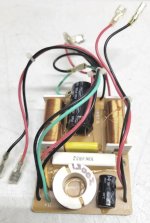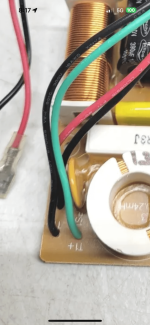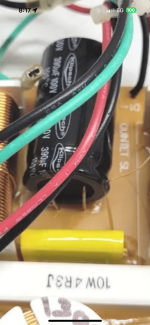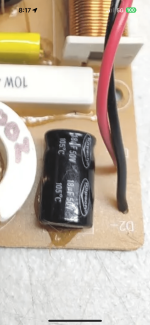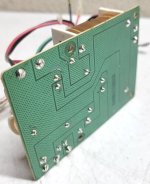Prologue:
I realize, for example, a passive “8 ohm nominal” rated home speaker’s impedance/resistance will vary greatly when being used, but will “generally” (in my experience) measure somewhere roughly between 4 and 10 ohms when at rest.
So, when I pick up used speakers, I’ll measure their resting impedance before hooking them up to my amp for no other reason than to make sure there isn’t something wacky going on that might trigger my amp’s protection circuitry or otherwise harm it.
I picked up some used klipsch speakers (2 way, 2 woofers + 1 tweeter, nominal 8 ohm). One measures 15 megaohms and the other measures 21 megaohms.
That seems way out of the ordinary so I opened them up. I disconnected the tweeters and woofers and they all measure what you’d expect on their own (something like 5-ish ohms). Not shorted and not “open”.
So now I’m looking at this crossover and trying to figure out where to start looking for problems. Nothing appears “wrong” based on appearances. No bulging caps, or burn marks, etc. My first thought was that thermistor, but (in circuit) it measures 0.4 ohms, which seems reasonable. Am I wasting time measuring any of the components “in circuit” or must they be removed, the caps are glued to the board and will have to be pryed off.
I realize, for example, a passive “8 ohm nominal” rated home speaker’s impedance/resistance will vary greatly when being used, but will “generally” (in my experience) measure somewhere roughly between 4 and 10 ohms when at rest.
So, when I pick up used speakers, I’ll measure their resting impedance before hooking them up to my amp for no other reason than to make sure there isn’t something wacky going on that might trigger my amp’s protection circuitry or otherwise harm it.
I picked up some used klipsch speakers (2 way, 2 woofers + 1 tweeter, nominal 8 ohm). One measures 15 megaohms and the other measures 21 megaohms.
That seems way out of the ordinary so I opened them up. I disconnected the tweeters and woofers and they all measure what you’d expect on their own (something like 5-ish ohms). Not shorted and not “open”.
So now I’m looking at this crossover and trying to figure out where to start looking for problems. Nothing appears “wrong” based on appearances. No bulging caps, or burn marks, etc. My first thought was that thermistor, but (in circuit) it measures 0.4 ohms, which seems reasonable. Am I wasting time measuring any of the components “in circuit” or must they be removed, the caps are glued to the board and will have to be pryed off.
Attachments
i'm guessing woofers usually have a d.c. connection to the speaker input terminals through a coil or two. so, if you're measuring very high resistance, I'd check the coils for opens or check for really bad solder joints first.
Good luck!
Good luck!
Measuring dcr at the speaker cabinet terminal may show such resistance, were the driver(s) high passed (capacitor).
That 390 uF cap could be it, for the woofers. Do the speakers play alright, as a whole?
That 390 uF cap could be it, for the woofers. Do the speakers play alright, as a whole?
Last edited:
Measuring dcr at the speaker cabinet terminal may show such resistance, were the driver(s) high passed (capacitor).
That 390 uF cap could be it, for the woofers. Do the speakers play alright?
I’m not 100% following. Are you saying a passive loudspeaker’s impedance measuring in the mega ohms at the cabinet terminals is normal in your experience?
I haven’t hooked them up because they seem borderline “shorted” and I don’t want to take a chance on harming my amp.
I did do the trick of using a 9v battery to touch the terminals quickly after I measured that extremely high resting impedance. You’ll usually get a crackling sound. It’s a somewhat controversial way of identifying speakers when you’re at the other end of a cable, etc. that I’ve been doing for years with no issues. Anyway, these speakers didn’t make a peep! Lol.
If a capacitor (HP filter) is in series with an inductor (LP filter) and these two in series with a woofer, then a dcr test can not show dcr of the network because a dc signal can not pass a capacitor, only ac signal can. Trace the x/o board. Start from + In at the cabinet terminal.
This is not always wrong. You need something like Dayton DATS or REW with an impedance jig to do this correctly.
Ok Erik. Thanks. I remembered I do have DATS. I’ll do a sweep on the speaker I haven’t taken apart tonight. But I must say, I’ve measured a lot of speakers and never ran across one that had a resting impedance in the mega ohms.
Any idea why the 9v battery trick didn’t result in any sound from the speaker? I usually get a slight crackle/static.
Any idea why the 9v battery trick didn’t result in any sound from the speaker? I usually get a slight crackle/static.
Could you repeat the battery test but with inverted polarity ? And if you repeat it change the polarity each time you make contact. If this speaker has a capacitor in series of the woofer it would measure "open" (more than 10 M Ohms is almost "open"). But it should still make a click with the battery test but the latter would have to be reversed each time you try it - therby mimicking an AC source. Otherwise there isn't any current flowing anymore once the series capacitor is charged.
But your open speakers could of course also be due to some defect - but at least not due to burnt voice-coils since they seem to measure fine. But I would at first use the trick with the battery reversal.
Regards
Charles
But your open speakers could of course also be due to some defect - but at least not due to burnt voice-coils since they seem to measure fine. But I would at first use the trick with the battery reversal.
Regards
Charles
That 390 uF cap could be it, for the woofers.
This speaker may incorporate a 390 uF series capacitor in order to change the order of the bass loading.
For a vented speaker this results in 5th order bass loading and for a sealed speaker it results in 3rd order.
An infinity reading on an ohmmeter connected to the loudspeaker terminals is the result of this large value capacitor blocking DC.
I suggest the OP connect the ohmmeter after the 390 uF capacitor when he should measure 6 ohms or so of resistance.
I realize, for example, a passive “8 ohm nominal” rated home speaker’s impedance/resistance will vary greatly when being used, but will “generally” (in my experience) measure somewhere roughly between 4 and 10 ohms when at rest.
Uhm, no. The impedance doesn't change when used, it fluctuates over the frequency range. It can rise with enough power (=heat).
If you are worried over the amp then just stick low value resistor in series with the speaker for testing. Something in 4.7 to 10 ohm range would be fine.I haven’t hooked them up because they seem borderline “shorted” and I don’t want to take a chance on harming my amp.
Sounds odd if a 9v battery is silent, even a meter on diode range is more than enough to get a faint noise from a speaker.
If you are worried over the amp then just stick low value resistor in series with the speaker for testing. Something in 4.7 to 10 ohm range would be fine.
Sounds odd if a 9v battery is silent, even a meter on diode range is more than enough to get a faint noise from a speaker.
I agree on the odd 9v battery result. That’s why I came here to ask you all. First a super high resting impedance and then no sound from the battery (on both speakers). Drivers measure good and nothing obviously “blown” on the xover board.
It should be an easy one to trace.
Why not link out the big cap and retest on your meter.
Why not link out the big cap and retest on your meter.
Uhm, no. The impedance doesn't change when used, it fluctuates over the frequency range. It can rise with enough power (=heat).
Uh, yea. I know. I just wanted to make it known that I understood the difference between the resting measured impedance of a speaker versus the varying impedance the amp sees while the speaker is being used to play sound from a source.
Touching the cone or even simply making noise while the speaker isn’t being used can change its resting impedance.
Regardless, the point of this post isn’t ultimately about that anyway. It’s why the resting impedance is so very high when I’ve never run across that before and what the cause/reason might be, and would it be safe to connect to an amp to test further.
It should be an easy one to trace.
Why not link out the big cap and retest on your meter.
Link out?
I was just about to suggest the same as Mooly!
Connect a shorting link across the terminals of the 390 uF capacitor then measure the DC resistance at the speaker terminals.
Connect a shorting link across the terminals of the 390 uF capacitor then measure the DC resistance at the speaker terminals.
With the capacitor in series I'd have expected an initial low resistance then rising as the capacitor is charged.
Very high resistance is probably open circuit and your body conducting if you have fingers on the meter probes.
Very high resistance is probably open circuit and your body conducting if you have fingers on the meter probes.
Will try this evening 🙂I was just about to suggest the same as Mooly!
Connect a shorting link across the terminals of the 390 uF capacitor then measure the DC resistance at the speaker terminals.
- Home
- Loudspeakers
- Multi-Way
- Troubleshooting speaker showing mega-ohms of resistance?
